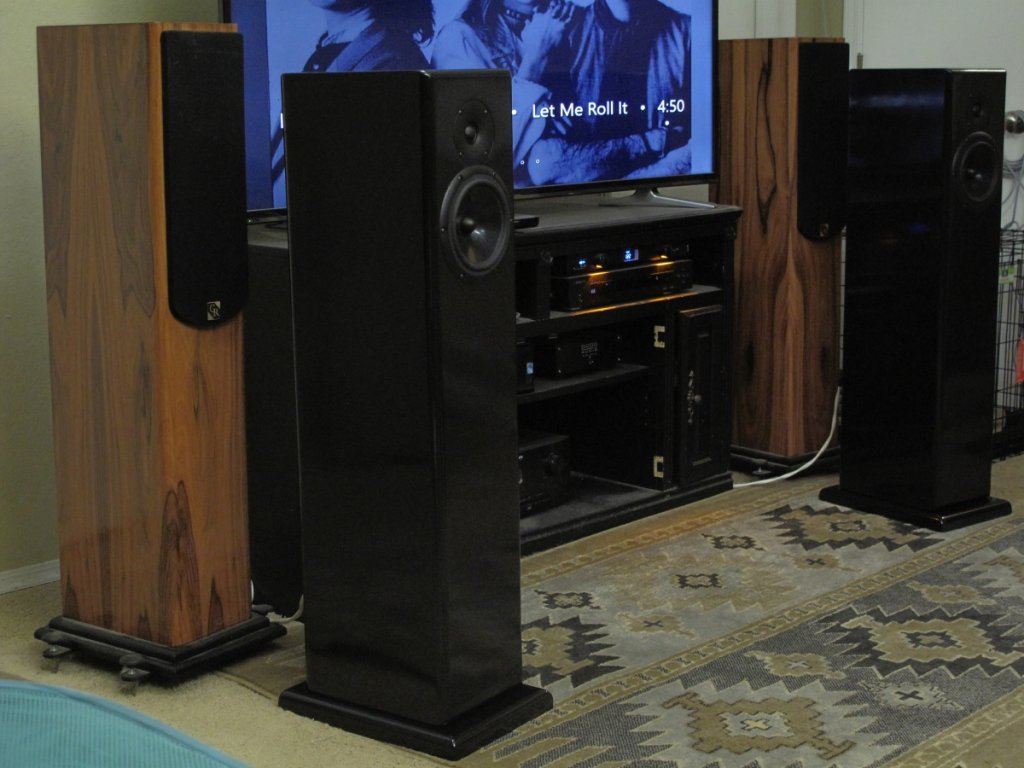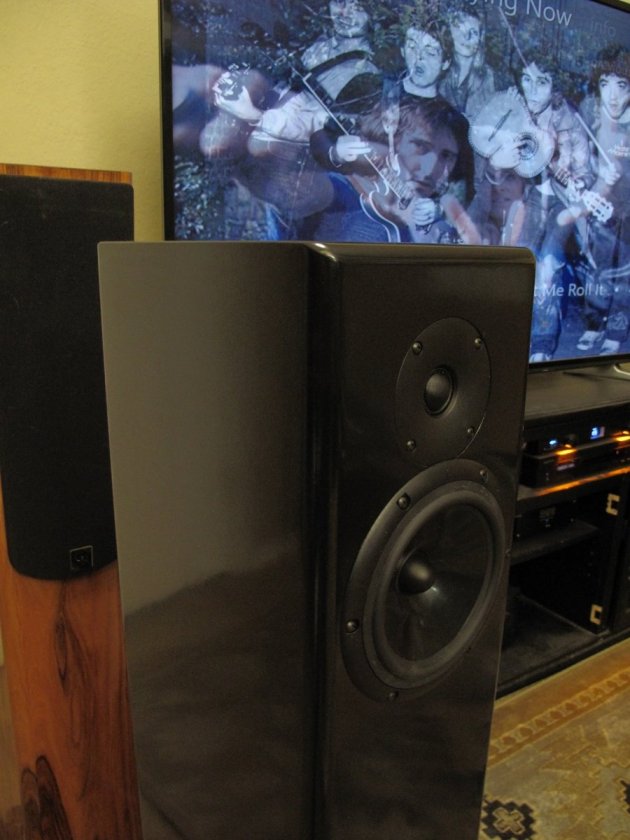Rearranged my normal Tuesday night to detour by Michael’s to hear the GR Research X-SLS before they head off to their new owner, correction
lucky new owner.
The short version is the Danny and Michael team deliver performance well above what the same dollars buys via retail channels.

We auditioned on Michael’s downstairs AV system rather than his more high-end system we see at LSAF that resides in his upstairs music room. Signal chain was media center PC running JRiver to Dodd DAC to Marantz HT receiver in 2-channel mode (no subs or surround) to X-SLSs. We listened to classic and progressive rock, jazz, pop, soundtracks, and audiophile demo favorites.
Bass has impressive depth, tightness, and texture. I have a preference for the now rare sealed box bass designs because I value the tight critically damped bass they deliver. As a result vented boxes as used by X-SLS need to be just so to please me. With its generously sized box and what my ears tell me is Danny’s expert vented bass alignment of the M165 driver with its obviously linear characteristics the result is the X-SLS sounds like a much larger system. Looking at the bracing pictures on page one of this thread shows an example of how this design is overbuilt compared to its price peers and that extra enclosure stiffness is heard as clean bass that does not muddy up the midrange. With the quality checked off the bass quantity can be appreciated. A pet peeve of mine with 21st century Hi-Fi is all too often speakers feature thin weak bass and mid-bass. I speculate the designers think it makes than sound more transparent or they lack the experience to get the baffle step correction right. The X-SLS is the antithesis of those misguided designs with a rich strong mid-bass and true lower bass that satisfies.
Imaging and transparency. We jumped around the selections Mike has on that server each from a different artist, album, and across decades of music. Quickly it became apparent that for each cut the soundstage would change responding to what the recording presented. Any stereo does that to some degree, what was striking is how explicit the X-SLS was in this aspect. A visual analogy occurred to me. When watching the latest generation of 4k wide color range HDTVs the differences between video in DVD, Blu-ray, and 4k resolutions is immediately apparent. The panel is so good it is easy to see. Likewise the X-SLS is open and does not obscure what is on the recording instead presenting it as captured. Images were nicely detached from the speaker locations. On some songs from early rock bands a bundle of frantic rocking energy appeared between the speakers. Other songs array performers precisely each in their own specific space. When captured in the recording images effortlessly appear to the left of the left speaker and right of the right speaker. This trait of very explicit imaging also made it easy to hear when on pop multitrack productions the vocalist is overdubbed to double or triple themselves.
Transparency in Hi-Fi I define as the ability to hear deep into the recording both the production details and the highly unique harmonic signatures of voices’ and instruments’ unique sounds. Score another win for X-SLS in this regard. This level of transparency combined with the full bass is something of a having ones cake and eating it too thing. Too often one obscures the other, very expert balancing here.
Vocals just work. In the 1970s and ‘80s when I first seriously got into Hi-Fi ‘presence’ was a trait often mentioned as a very good attribute for a speaker to have. Singers ranging from Adele, to Dean Martin, to John Fogerty were present with us in Michael’s room.
Tweeter up to task? Yes they are. I tend to favor hard domes, ribbon, and horn tweeters for their extended response and ‘fast’ detailed sonic signatures. Thus I was curious how the T26SG soft dome silk tweeters in the X-SLS perform. The soft dome sound is different but easily adequate to the task. One could argue the soft dome sound as heard here is more often representative of actual sounds in that they never sounded unnaturally harsh or zinging. I expect the crossover parts upgrades and tube connectors featured in this pair also helped both treble and transparency. Its nets out to smooth yet detailed and certainly more forgiving of the all too common musically interesting yet marginally recorded material. Conversely when really finely recorded high frequencies are presented they were reproduced with detail and filigrees intact.
In summary I really enjoyed a couple of hours listening to the GR Research X-SLS. They sound refined and impressive. When the landed cost is taken into account the value is outstanding.
A closing comment on Michael Lundy’s craftsmanship. As the photos show the man is skilled, meticulous and does not stop until it is right. I was impressed by the base, edge round overs, and tweeter fit and recess. The semi-gloss black paint looks good and would be perfect for use by video screens. I would go veneer as Michael works magic with wood finishing. This you can see in the photos on the pair of GR N3 that normally reside in the Lundy’s downstairs system.
